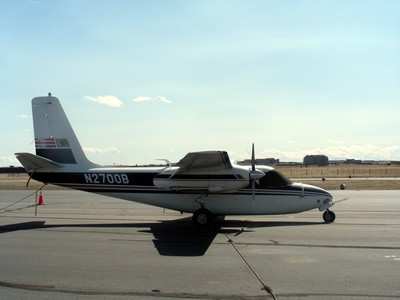Dead-Sticks Onto Interstate
 There are some days when one's luck simply seems to be going
form bad to worse... like the feeling one gets when one feathers a
dead engine in a twin... sees the other taking a dive shortly
thereafter. Here's just such a case in point.
There are some days when one's luck simply seems to be going
form bad to worse... like the feeling one gets when one feathers a
dead engine in a twin... sees the other taking a dive shortly
thereafter. Here's just such a case in point.
NTSB Identification: ERA10LA457
14 CFR Part 91: General Aviation
Accident occurred Tuesday, August 31, 2010 in Jacksonville,
FL
Aircraft: AERO COMMANDER 560E, registration: N175SP
Injuries: 2 Uninjured.
This is preliminary information, subject to change, and may
contain errors. Any errors in this report will be corrected when
the final report has been completed.
On August 31, 2010, about 0815 eastern daylight time, an Aero
Commander 560E, N175SP (previously registered as N6SP), was
substantially damaged during a forced landing, after experiencing a
loss of engine power during the initial climb after takeoff from
the Herlong Airport (HEG), Jacksonville, Florida. The certificated
private pilot and a certificated flight instructor (CFI) were not
injured. Visual meteorological conditions prevailed and no flight
plan had been filed for the flight destined for Craig Municipal
Airport (CRG), also located in Jacksonville, Florida. The personal
flight was conducted under the provisions of 14 Code of Federal
Regulations Part 91.
During an interview, the pilot reported that he purchased the
airplane on June 19, 2010. The airplane was previously owned by the
Delaware State Police, and had not been flown for over 1 year. On
July 23, 2010, after maintenance which included an annual
inspection, the pilot took delivery of the airplane in Delaware,
and flew it to HEG.
The purpose of the accident flight was to fly to CRG for
avionics related maintenance. The pilot performed a preflight
inspection, which included checking the fuel tanks for water
contamination, prior to the flight. The pilot and CFI, who the
pilot considered a safety pilot per insurance requirements,
departed without incident. The airplane was in a climb between
1,500 and 2,000 feet, when the left engine quit. The pilot
successfully feathered the engine; however, shortly thereafter, the
right engine began to "sputter" and also quit. The pilot was unable
to restore engine power in either engine, and performed a forced
landing to Interstate I-10. During the landing, the airplane struck
trees, which resulted in substantial damage to both wings and the
fuselage.

Aero Commander 560 (File Photo)
The CFI reported that he assumed control of the airplane
immediately after the left engine failed. He secured the left
engine and subsequently maneuvered the airplane for the forced
landing. While on approach, he observed power lines which
necessitated lowering the airplane's nose, and increased the
touchdown airspeed. During the landing roll, the airplane's right
tire departed the paved surface, and the airplane veered into
trees, toward a fence.
The airplane was subsequently removed from the accident site for
further examination to be conducted under the supervision of a
Federal Aviation Administration (FAA) inspector, at a later
date.
The pilot further reported that the airplane had been operated
for about 20 hours since it was purchased, and was last flown on
August 11, 2010. At that time, fuel was added to the airplane which
brought the total fuel on board to approximately 80 gallons in the
main fuel tanks, and 20 gallons in the auxiliary fuel tanks.
The pilot reported 250 hours of total flight experience, which
included about 90 hours in multiengine airplanes. His most recent
application for an FAA third-class medical certificate was issued
on September 15, 2009.
 ANN's Daily Aero-Linx (04.16.24)
ANN's Daily Aero-Linx (04.16.24) Aero-News: Quote of the Day (04.16.24)
Aero-News: Quote of the Day (04.16.24) Airborne 04.10.24: SnF24!, A50 Heritage Reveal, HeliCycle!, Montaer MC-01
Airborne 04.10.24: SnF24!, A50 Heritage Reveal, HeliCycle!, Montaer MC-01 Airborne 04.12.24: SnF24!, G100UL Is Here, Holy Micro, Plane Tags
Airborne 04.12.24: SnF24!, G100UL Is Here, Holy Micro, Plane Tags Airborne-Flight Training 04.17.24: Feds Need Controllers, Spirit Delay, Redbird
Airborne-Flight Training 04.17.24: Feds Need Controllers, Spirit Delay, Redbird




